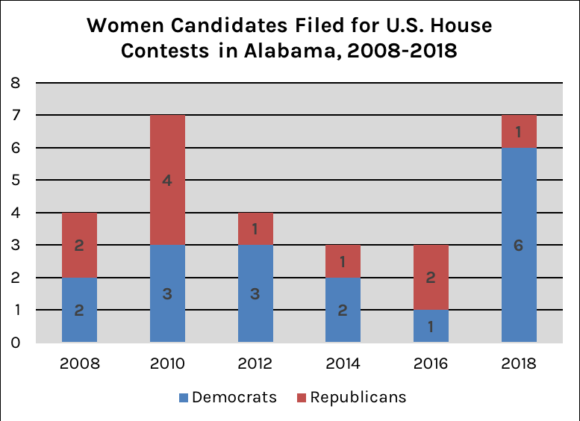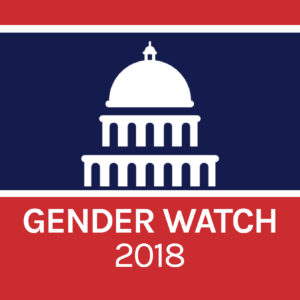
Ahead of the Alabama primary election on June 5, 2018, we outline the numbers and proportions of women who have filed as candidates for congressional and statewide office. The data below also provide points of historical comparison to give context to today’s presence and potential success of women candidates.
All data are provided from the Center for American Women and Politics, Eagleton Institute of Politics, Rutgers University. For a full list of the women candidates in AL primary races for congressional and statewide offices, see CAWP’s Election Watch page.
CONGRESS
Current: 2 of 9 members of the Alabama congressional delegation (22.2%)
Filed: 7 (6D, 1R)
Percent of all Filed Congressional Candidates (D/R): 30.4% (7 of 23)
SENATE
Current: 0 of 2 senators
- Two women have served in the U.S. Senate from Alabama, both unelected. In 1937, Dixie Bibb Graves (D) was appointed by her husband – Governor Bibb Graves – to fill a vacancy caused by resignation. She served in the Senate for 5 months. In 1978, Maryon Pittman Allen (D) was appointed to the U.S. Senate to replace her deceased husband. She served in the Senate for 5 months. No woman has served in the Senate from Alabama since then.
THERE IS NO U.S. SENATE RACE IN ALABAMA THIS YEAR.
HOUSE
Current: 2 of 7 representatives (28.6%)
- A total of 3 (2D, 1R) women have represented Alabama in the U.S. House, including current Representatives Martha Roby (R) and Terri Sewell (D).
Filed: 7 (6D, 1R)
- Both incumbent Representatives Roby (R) and Sewell (D) are running for re-election this year.
- All non-incumbent women candidates for the U.S. House in Alabama are Democrats seeking to challenge Republican incumbents in the general election.
- There are no open seat contests for the U.S. House in Alabama this year.
- Of the 7 women candidates for the U.S. House this year, 4 (4D) are Black women.
Districts with Women Candidates: 4 of 7
Percent of all Filed House Candidates (D/R): 30.4% (7 of 23)
Percent of all Filed Democratic House Candidates: 54.5% (6 of 11)
Percent of all Filed Republican House Candidates: 8.3% (1 of 12)

Recent history: The number of women who filed for major party candidacy for the U.S. House in Alabama in 2018 matches the highest number of women candidates between 2008 and 2018. In 2010, when there were 2 open U.S. Houses seat being contested, 7 women filed for major party candidacy. This year, there are no open House seats in Alabama.
- The highest number of Democratic women running for the U.S. House in Alabama between 2008 and 2016 was 3 in 2010. This year, 6 Democratic women filed to run for House seats. The highest number of Republican women candidates in the past decade was 4 in 2010. Just one Republican woman candidate is running this year.
GOVERNOR
Current: 1
Current Governor Kay Ivey (R-AL) is the second woman governor of Alabama. She succeeded the previous governor in 2017 due to resignation. If elected this year, she would become the first woman elected governor from Alabama in her own right. In 1967, Lurleen Wallace (D) was elected as a surrogate for her husband who could not run for re-election.
Filed: 2 (1D, 1R)
- Republican incumbent governor Kay Ivey is running for re-election.
- Democrat Sue Bell Cobb is running to challenge Ivey in the general election.
Percent of all Filed Gubernatorial Candidates (D/R): 20% (2 of 10)
Percent of all Filed Democratic Gubernatorial Candidates: 16.7% (1 of 6)
Percent of all Filed Republican Gubernatorial Candidates: 25% (1 of 4)
Recent history: No women have competed for major party nominations for governor in Alabama in the past decade. The only woman major party nominee for governor of Alabama has been Lucy Baxley, who ran as a Democratic challenger in 2006.
OTHER STATEWIDE ELECTED EXECUTIVE OFFICES
Current: 1 of 9 positions (excludes governor) (11.1%)
Filed: 8 (5D, 3R)
- Republican Twinkle Cavanaugh is running for the state’s open lieutenant governor position against two men.
- 2 Republican women are challenging incumbents in their own party for nominations for Attorney General and Public Service Commissioner.
- 5 Democratic women are seeking Democratic nominations for Secretary of State, Auditor, and Public Service Commissioner to challenge Republican incumbents in the general election.
- There are no women candidates for 2 statewide executive offices up for election this year (State Treasurer and Commissioner of Agriculture).
Percent of all Filed Statewide Executive (other than governor) Candidates (D/R): 25.8 % (8 of 31)
Percent of all Filed Democratic Statewide Executive (other than governor) Candidates (D/R): 62.5% (5 of 8)
Percent of all Filed Republican Statewide Executive (other than governor) Candidates (D/R): 13% (3 of 23)
Recent history: The number of women who filed for major party candidacy for statewide elected executive offices (other than governor) in Alabama is higher than any other year in the past decade. In 2010, 7 (3D, 4R) women filed as candidates for these offices.


 From March to December 2018, the
From March to December 2018, the 